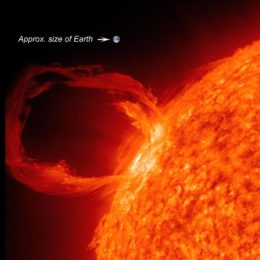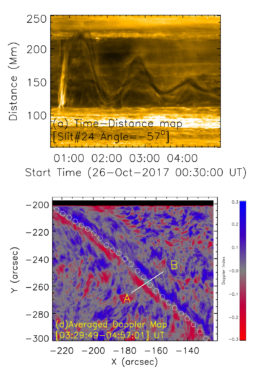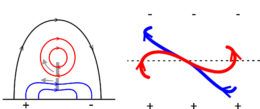Images of the Sun’s chromosphere often reveal dark threads cutting across the Sun’s face. New research has now explored how these solar filaments are built from magnetic fields and plasma.
Two-Faced Structures

A solar eruptive prominence as seen in extreme UV light on March 30, 2010, with Earth superimposed for a sense of scale. [NASA/SDO]
Unfamiliar with filaments? You’ve likely seen plenty of them in images — but from a different angle! Filaments are the same structures as solar prominences, the loops of plasma we can see suspended above the Sun’s limbs. When prominences appear on the side of the Sun facing us, they take the form of filaments from our point of view.
Shaped by Fields
Filaments are often associated with various forms of solar activity. They last for days, frequently hanging above active regions of the Sun; filament channels are often the origin of eruptions from the Sun’s surface. To better understand our active and energetic Sun, understanding the structures of filaments is an important step.
Unfortunately, this is challenging! We know that filament structure is largely due to the magnetic fields — whose forces suspend the filaments against the downward pull of gravity — but we don’t have the ability to directly measure the magnetic field in the Sun’s atmosphere. A team of scientists at the University of Science and Technology of China has instead taken an indirect approach: they explored filaments by looking at the motion of plasma along them.

Top: time-distance map characterizing the oscillations at one position on the filament spine. Bottom: a Doppler map, averaged over time, that shows the rotation around the spine of the filament. Blue indicates motion toward the observer, red away. [Adapted from Awasthi et al. 2019]
A Double Decker?
Scientists Arun Awasthi, Rui Liu, and Yuming Wang examined observations of a filament that appeared near active region AR 12685 in October 2017, captured with the 1-m New Vacuum Solar Telescope in China. The team used these high-resolution images to explore bulk motions of plasma in the filament.
Awasthi and collaborators found that the filament displayed two different types of motion: rotation around its central spine, and longitudinal oscillations along its spine. The longitudinal oscillations in the eastern segment of the filament were distinct from those in the west, suggesting that the magnetic field lines underneath these two segments have different lengths and curvatures.
On the whole, the motions observed in the filament indicate that magnetic structure for filaments is complicated. The authors argue that more than one model is likely at work; they propose a “double-decker” picture for the filament in which a flux rope (a twisted bundle of magnetic field lines) sits on top of a sheared arcade (a series of distorted loops).

Proposed “double-decker” configuration of the magnetic field hosting the filament, consisting of a flux rope (red) atop a sheared arcade (blue). Left panel shows the cross section viewed from the west; right panel shows the structure viewed from above. [Adapted from Awasthi et al. 2019]
Bonus
Check out the video below showing the motions in the filament in different wavelengths. Top panel: GOES light curve and an HMI magnetogram. Bottom panels: AIA 171 Å image, GONG Hα image, and NVST Hα image.
Citation
“Double-decker Filament Configuration Revealed by Mass Motions,” Arun Kumar Awasthi et al 2019 ApJ 872 109. doi:10.3847/1538-4357/aafdad

7 Comments
Pingback: AAS Nova – New
Pingback: Daily Study Log (2019-04-18) | Study Astrophysics
Pingback: Exploran filamentos del Sol – Observatori Astronòmic
Pingback: Mayo 2019 – Observatori Astronòmic
Pingback: Exploran filamentos del Sol « SEDA / LIADA - RedLIADA - Cursos LIADA - Cielo del Mes - Fenómenos Astronómicos - RELEA
Pingback: Exploran filamentos del Sol – Astronomía Fácil
Pingback: Exploran filamentos del Sol « Observación Solar de la LIADA